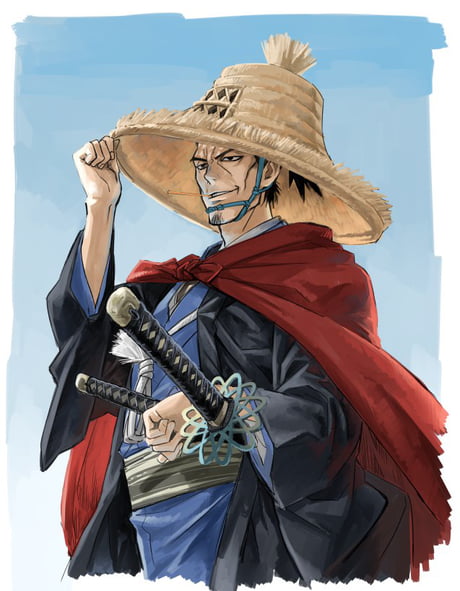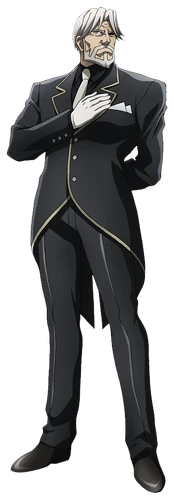“My art is different from yours. It consists not so much in defeating others but in not being defeated.”
Name: Tsukahara Bokuden
Title(s): Sword Saint
Class: Saber
Gender: Male
Attribute: Human
Alignment: Neutral Good
Personality: Bokuden is a warrior who has fought in many battles, defeated multiple famed opponents, and who feels he no longer has anything to prove. The adventurous spirit he had in his youth has been sated, having travelled the country three times over on pilgrimages, and his desire to prove his strength and his skill has been replaced by a calm and assured confidence in his own abilities.
He is a warrior who seeks to avoid unnecessary conflict, a rarity for a samurai born and raised in a tumultuous time of war and bloodshed, who would rather talk his way out of a fight that draw blood if possible.
Objective for the Grail: “It’s a small and somewhat selfish wish, but I’d like to see the school I created restored to its former glory. My techniques were given to me by Takemikazuchi , so to see them lost to time and war saddens me.”
Biography: Bokuden was born in 1489 as the second son to Yoshikawa family, Shinto priests of the Kashima shrine who were in the service of the Kashima clan. The Kashima shrine was considered to be a holy place of Budo, or Japanese martial arts, as a thousand years prior a priestly celebrant named Kuninazu-no-Mahito built an altar at Kashima Shrine and by praying day and night he attained the secret techniques of the Divine Sword; these techniques were passed on mainly to the Yoshikawa family by the Shinto priests of Kashima Shrine. These secret techniques are called Kashima-no-Tachi (the Sword of Kashima) and, as the time passed, their name was changed from Kashima Jōko-ryū to Kashima Chuko-ryū. As a child Tsukahara Bokuden was taught the family heirloom of Kashima Chuko-ryū by his father Akikata.
At the age of 10 he was requested for service and adopted by the Lord of Tsukahara Castle, Tsukahara Tosanokami Yasumoto. This man was the advanced student of the founder of Tenshinshouden Katori Shinto-ryū, and he taught Bokuden the style called Katori Shinto-ryū. From his early life Bokuden was taught two styles of Kashima and Katori by his fathers and, during his early years, he already distinguished himself as the one having outstanding skills in swordsmanship.
At the age of 17 Bokuden set out on his first of three pilgrimages, during which he found his first real taste of combat against the renowned swordsman Ochiai; Bokuden defeated him easily and chose to spare the man, only for his humiliated opponent to try and ambush him later in revenge. Bokuden killed the more skilled opponent with a single cut and was then forced to take the Ochiai’s place in the armies of the local daimyo as a result. He spent the next few years fighting in fierce battles, often on the front lines, and didn’t return home until nearly thirteen years after his departure.
Upon returning home the first time, he isolated himself for prayer as Kashima shrine at the advice of his master to repair the spiritual damage of many life-or-death encounters. It was a rigorous ascetic practice that lasted about 1000 days, during which he stayed at Kashima Shrine and practiced the art of the sword, praying to the deity of warfare, Takemikazuchi. Through this ascetic training Bokuden acquired the secret techniques of “Hitotsu-no-Tachi”, or “One Stroke”, from Takemikazuchi who appeared to him in his dreams. Combining these techniques with his existing style, Bokuden then began to call his style Kashima Shinto-ryū from then on.
Tsukahara Bokuden became the lord of Tsukahara Castle at the end of his second pilgrimage at the age of 45, taking a wife who unfortunately died only ten years later. By the time of his third pilgrimage he was famous enough to be followed by a large retinue on his travels, attended to by eighty followers and bringing along multiple spare horses and three large hawks which flew at the head of his procession. It was at this point that he decided to take on a student in order to pass on his techniques and experience to the next generation.
In his later years, Bokuden handed over his place at Tsukahara Castle to his son in order to convert to Zen and become a Buddhist priest. He died at the age of 83.
Weapon: Odachi and Kodachi (long sword and short sword)
Parameters:STR: B
END: C
AGI: A
MGI: E
LCK: A
Class Skills: Magic Resistance (B) – Aside from being a famed Samurai, Tsukahara is also the latest in a long line of Magus; his family, in their service of the Kashima shrine, were diviners practiced in the art of Urabe fortune telling. Although never trained as a Magus himself, Tsukahara still possesses magic circuits and has some innate protection against Magecraft. Cancel spells with a chant below three verses. Even if targeted by High-Thaumaturgy and Greater Rituals, it is difficult for them to be affected.
Riding (C) – Most vehicles and animals can be handled with above average skill. However, cannot ride the likes of Phantasmal Species such as Monstrous Beasts.
Personal Skills:Eye of the Mind (False) (A) – Eye of the Mind represents a natural talent to foresee/sense and avoid danger on the basis of an innate 6th sense, intuition, or prescience that has been further enhanced by experience and skill. In life Tsukahara was a preternaturally skilled swordsman, one who was able to defeat many famed opponents and take part in multiple battles at the site of the fiercest fighting without once being injured by his opponents.
From his first duel with live blades at the age to 17 to his retirement from combat in old age, defeating all challengers and surviving ambushes and assassinations, Tsukahara killed over 200 men without once feeling the sting of a blade. It could be said that Tsukahara’s swordsmanship is at the level where trying to attack him with a melee weapon of any kind of pointless. He doesn’t have the best of luck with arrows however.
Kashima Shintō-ryū (A++) – A school of traditional Japanese swordsmanship created by Tsukahara Bokuden after spending 1000 days training at the Kashima Shrine and praying to the deity of warfare, Takemikazuchi. It was said that Takemikazuchi appeared to him in a dream and taught him the secrets of “Hitotsu-no-Tachi”, or “one sword/stroke”, after which he renamed his style Kashima Shintō-ryū after the shrine. As the creator and first master of this style, Tsukahara has a rank above A in this skill.
Created during a time of feudal war, the school's techniques are based on battlefield experience and revolve around finding weak points in the opponent's armour, thus giving Tsukahara an advantage against armoured opponents that he might otherwise have difficulty fighting. The style also contains a number of iaijutsu techniques that allow for striking as the sword is drawn.
Disengage (B) – In his later life Tsukahara grew tired of constantly feeling the need to prove himself against strong opponents as he was already extremely confident in his abilities and he began to see the merit in avoiding conflict as opposed to having to constantly show himself to be the best. This mentality culminated in the creation of the “No Sword Style”, where Tsukahara defeated an arrogant younger opponent by tricking him into jumping off of the ferry they were on to have a duel and then promptly leaving him on an island alone. Has the effect of returning battle conditions to what they were at the beginning of the match (1st turn) and restores the condition of this Skill to the initial value.
Noble Phantasm:Name: Divine Sword Style - One Stroke
Title: Strike Without Fear of Reprisal
Rank: A
NP Type: Anti-Unit
Range: 1-2
Maximum Number of Targets: 1
Description: The ultimate technique granted to Tsukahara Bokuden at Kashima Shrine; taught to him in a dream by the God of Warfare Takemikazuchi at the end of his 1000 days of ascetic training. A counter attack delivered at the last possible moment before an opponent’s attack reaches, avoiding all damage and striking the opponent with an unavoidable swing of Tsukahara’s sword. However, while powerful this Noble Phantasm can only be used when Tsukahara has had a chance to view his opponent’s fighting style or techniques.
The essence of this technique lies in the wielder’s ability to accurately judge the distance between oneself and the opponent’s blade and in choosing the right moment to strike; if done correct the swordsman has nothing to fear as the enemies blade will never reach them and they are therefore able to devote all of their energy towards attacking at the moment they commit to an attack and leave themselves open. It was this technique that allowed Tsukahara to defeat his toughest opponents without receiving so much as a scratch in return.
It can also be used defensively, as even if Tsukahara’s sword cannot reach the enemy this Noble Phantasm can be used to parry or deflect attacks, as was done during his duel with a master of the naginata where he was able to intercept and destroy his opponent’s weapon before winning the duel with his next strike.


















